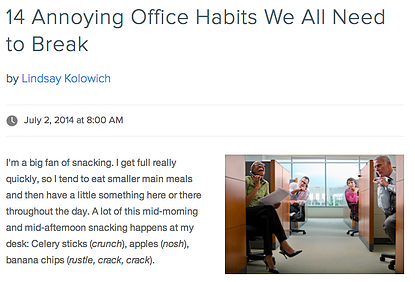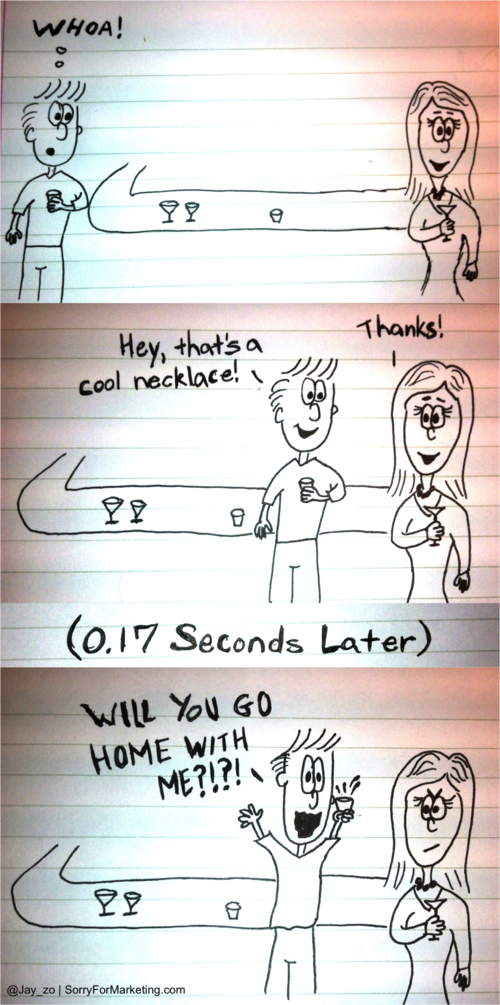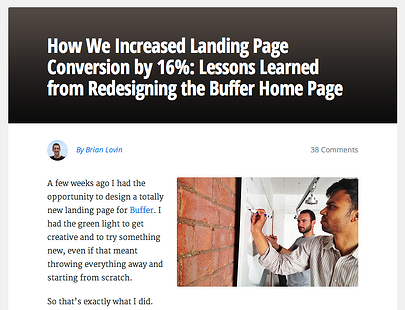Topics:
Content MarketingSubscribe now and get the latest podcast releases delivered straight to your inbox.
 We've all probably heard the saying "content is king", right?
We've all probably heard the saying "content is king", right?
I'm not here to tell you that it's not.
What I am here to tell you is that this quote is a little misleading. You see, content is critical to the growth of your business but not any old article or ebook will do.
What I'm trying to say here is that average content isn't the king of anything.
If you want to create something that people actually want to read and share, you have to focus on rising above the ordinary.
To help get you started, I've provided examples of 5 different content concepts that will get you noticed.
Don't be afraid to stir up some controversy
Back in April our CEO came across a video on YouTube that really rattled us. In summary, the video's creator Luke Nesler from Impkat Creative Marketing & Branding (ironic, we know) carries on for about 4 minutes or so about his aversion to HubSpot.
We weren't into that.
So when our marketing director John Bonini caught wind of the video, he took to our blog to set the record straight. As a result, his post - "Why I Despise HubSpot": The Story of an Ignorant Entrepreneur - was born.
When he published it, we sat there for a whiling wondering if it was perhaps, too harsh. Would people be turned off by it? Would they get it?
It was only a matter of minutes before we quickly realized, people not only got it, but they loved it. HubSpot users and non-users expressed their overwhelming support through the comment section on the blog...and it was really awesome.
In the month following its publish date, this post proved to be the 7th most visited page on our website. Not bad, huh?
Point being, don't be afraid to shake things up. If you have a strong opinion on something, state it. It's refreshing, it's liberating, and people love to see it done.
Focus on creating something relatable
 The advent of marketing automation has opened a ton of doors for marketers, however, poor adaptation of the tools has lead to some seriously robotic content.
The advent of marketing automation has opened a ton of doors for marketers, however, poor adaptation of the tools has lead to some seriously robotic content.
A lot of time marketers forget that they are humans, creating content for other humans. It's quite scary.
But truth be told, this type of static content doesn't invite engagement. It simply exists for the purposing of existing.
Rather than fall into this trap, you'll want to focus on bringing a human element back to content by creating something that people can relate to.
A great example of this in action is a post that was published on the HubSpot blog at the beginning of the month. The post - "14 Annoying Office Habits We All Need to Break" - written by Lindsay Kolowich is the epitome of relatable.
Aware that we've all had a run in with the "music so loud you can hear it through their headphones" guy and the "sneezing and coughing all over their desk" trooper, this post really hits home.
Find a way to provide inspiration
Last week I put together a SlideShare that highlighted 50 of the best pieces of entrepreneurial advice I'd ever come across. Take a look:
Between the visual format and the sharability of quick, inspirational quotes the presentation started to make it's way around the web.
The SlideShare was able to generated a few thousand views organically before I even promoted it on our blog or social media accounts. When I embedded it in a blog post on Monday, it picked up a couple thousand more views. I mean, it hasn't even been live for a week yet and it has already brought in over 8,000 views.
So what did I learn from this?
People love quotes. I mean, they reallllly love quotes.
And I'll have it been known that I'm not making this stuff up. According to research from QuickSprout, quotes get 847% more retweets than questions.
The thing to take away here is that any opportunity you have to inspire readers with quotes, seize it.
Don't underestimate the power of humor
What was the last piece of business content you read that actually made you laugh? I'm talking about a real-life "lol" here people.
If you're having some trouble, I don't blame you. A lot of business-related content is really buttoned-up stuff.
What these businesses are failing to recognize is that humor helps you connect with people. I mean, who doesn't love to laugh? When you make someone laugh, you're essentially humanizing your business.
Not to mention, humor is memorable. When we hear a good joke, we tell it to a friend. When we find a truly funny meme, we share it on social media. Funny content is sticky content.
To be quite honest, I didn't have to do much thinking when I went looking for an example to use for this section.
Why?
Probably because I'm still laughing about Jay Acunzo's "All The Weird Things Business People Do On Twitter" over a month later.
With that being said, it seemed like the obvious choice. Check out his real-life interpretation of the "too-soon social media request":

I mean, c'mon. Never gets old.
The one thing to keep in mind when incorporating humor into your content is making sure that it aligns with the audience you're trying to reach. While it's a great way to catch the attention of your audience, check with someone else before publishing anything risky.
Teach them something you've learned
 I think a lot of businesses are under the impression that they need to take all of their success secrets to the grave.
I think a lot of businesses are under the impression that they need to take all of their success secrets to the grave.
I mean, they literally hold onto their way of doing things like it's the Bush's baked beans secret recipe or something.
While it's okay to withhold some things, it's important to recognize the benefit of sharing, and more importantly, helping others achieve success.
If you can help someone, they're going to make note of that.
When Buffer redesigned their homepage, they didn't hesitate to spill the beans (pun intended) on what they uncovered in the process.
Their post "How We Increased Landing Page Conversion by 16%: Lessons Learned From Redesigning the Buffer Home Page" is the perfect example of a business out to help people.
Rather than keep to themselves, Buffer told all, which ultimately helped to establish them as a credible, valuable resource for people.
(Thanks for the tips, Buffer!)


Order Your Copy of Marcus Sheridan's New Book — Endless Customers!

